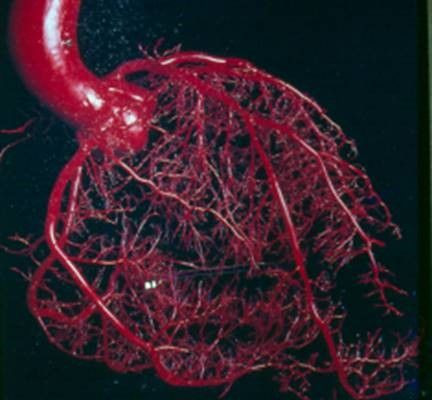Coronary heart disease (CHD) and Cardiac Rehabilitation
The coronary arteries are the vessels that take blood to the heart muscle. They arise from the root of the aorta, the body’s main artery, and wind round the surface of the heart in the shape of an upside-down papal crown or corona – hence their name. Their function is to supply the heart muscle with oxygen and nutrition.
Coronary artery disease is the narrowing of one or more of the coronary arteries, thus reducing the rate at which blood can flow through the artery. Coronary artery disease, more usually referred to as coronary heart disease (CHD), was until very recently the commonest cause of death in most developed societies (now narrowly overtaken in the UK by dementia for women).
In the UK approximately 2.3 million people have diagnosed CHD, with around 300,000 new cases every year. About 200 people in the UK die of CHD every day, mainly from heart attacks. It is also a cause of much morbidity – the symptoms and limitations resulting from the disease.
Causes of coronary disease
Coronary artery disease does not have a single cause. A number of ‘risk factors’ contribute to its development. Some are irreversible – age (the older you are, the more susceptible you are); gender (men develop CHD on average 10 years younger than women); and family history (you are at greater risk if you have a close relative with the disease, and the younger that relative, the greater the risk to you). You can’t do anything about these risk factors.
Other risk factors are reversible and can be prevented, mainly by lifestyle changes. They include cigarette-smoking, high blood pressure, diabetes, high blood cholesterol and obesity (and their combination). Overshadowing all of these, because it contributes to most of them, is lack of exercise.
There are several tools for predicting the risk of developing CHD in any individual. The best validated is the Q-Risk 3.
Click here to visit the Q-Risk 3 webpage
You will be asked to feed in your age, sex, height, weight, cholesterol/HDL ratio, blood pressure, presence or not of diabetes, ethnicity, smoking status, family history, deprivation, BMI, presence of rheumatoid arthritis or kidney disease, and postcode. Don’t worry if you do not know all of these. The risk-scoring system will just give you average values for missing data. From that information, the tool will calculate your risk of developing both CHD and cardiovascular disease (CVD) over the next 10 years.
Atheroma
Arterial narrowing is caused by a process called atheroma, or ‘hardening of the arteries’.As we grow older we develop patchy narrowing of the arteries due to fatty plaques composed of cholesterol being laid down in the arterial wall and compounded by overlying thin layers of blood clot. This gradually restricts the flow of blood to the heart muscle.
There are several ways in which coronary atheroma may present:
1. Angina pectoris
A point in the narrowing of a coronary artery may be reached when the artery is unable to supply the needs of the heart muscle during exercise – the muscle lacks a sufficient supply of oxygen to be able to continue to contract effectively and this produces pain during exertion – angina pectoris. This is a tight, strangling pain across the centre of the chest, often radiating into the throat, jaws or left arm. It forces the sufferer to stop exercising and then settles over the next few minutes.
2. Heart attack
The atheroma plaques are delicate creatures and may break, crack or burst. If this happens, the body’s repair mechanisms are set off and that usually means that a clot forms.
3. Heart failure
The modern treatment of heart attacks is extremely effective in limiting the damage done. Even so, if there is enough loss of myocardium (heart muscle), particularly after more than one attack, the ability of the heart to perform its full function is damaged. This can lead to heart failure. The term ‘heart failure’ sounds dire, but does not mean the end of life. It simply means that the heart is too weak to deliver all its potential output in daily activities. This causes fatigue, poor circulation with cold hands and feet, breathlessness on exertion and inability to carry out the tasks of daily living. If inadequately treated, it may cause ankle-swelling and breathlessness while at rest or when lying down at night.
The management of CHD
Angina
Most people with symptoms of angina need to have their coronary arteries investigated – either by angiography (injection of dye into the coronary arteries and Xraying the result) or by MRI scanning. Further treatment depends upon the extent of the disease – and might be medication alone or “revascularisation”. Revascularisation is either by passing a stent into the artery to widen the narrowed section or by operation, coronary artery bypass grafting.
Medication includes:
- Drugs which lessen the symptoms such as glyceryl trinitrate, other nitrates, beta blockers and calcium channel blockers like amlodipine and verapamil.
- Drugs which protect against recurrence or progression of the underlying atheroma. These include low dose aspirin, statins and ACE inhibitors like Ramipril.
Heart attack
The standard procedure for treating a heart attack is immediate coronary angiography with stenting of the blocked artery plus any other coronary artery which is thought to represent a threat for the future.






